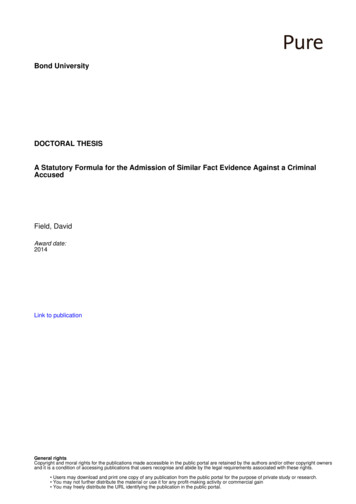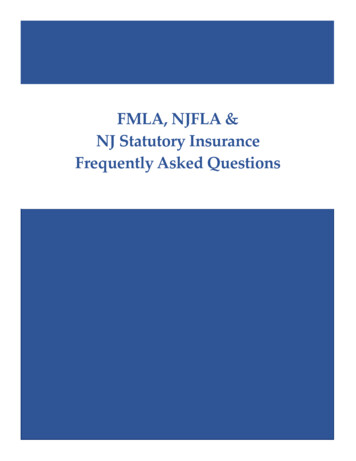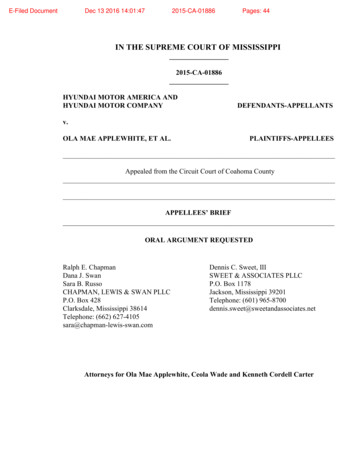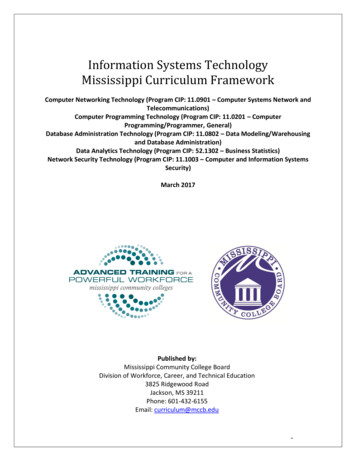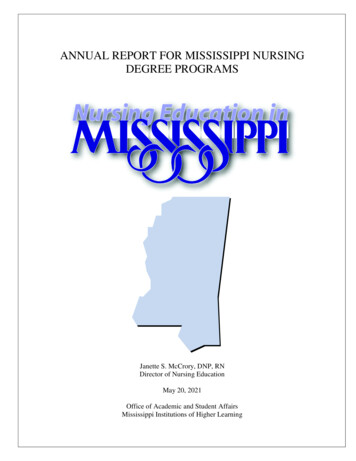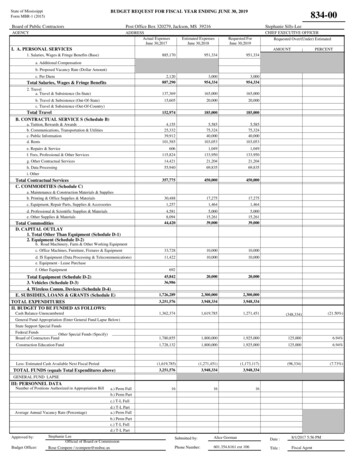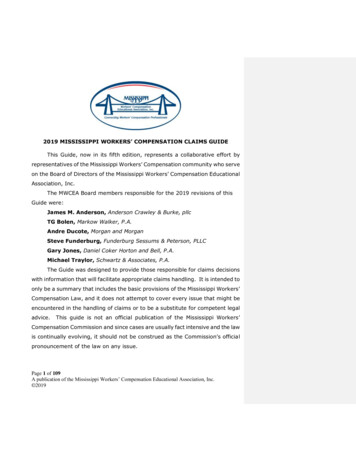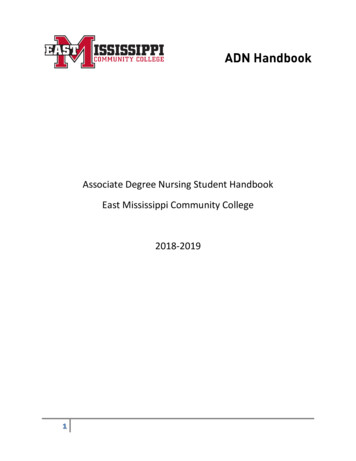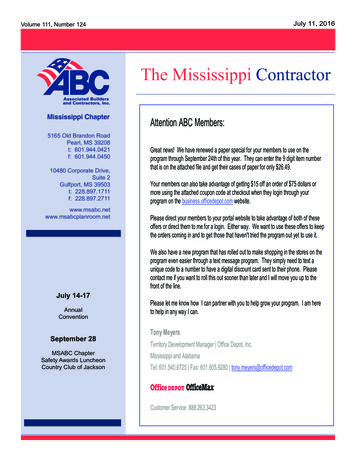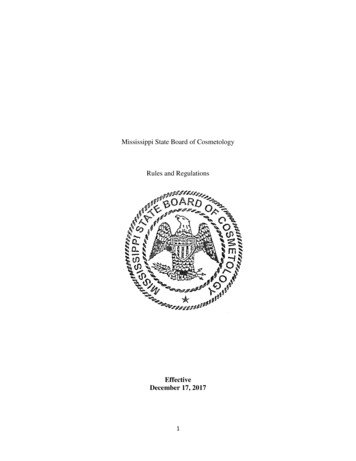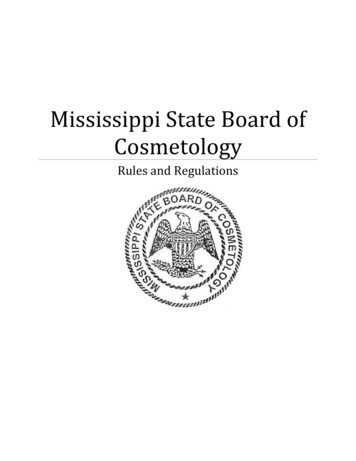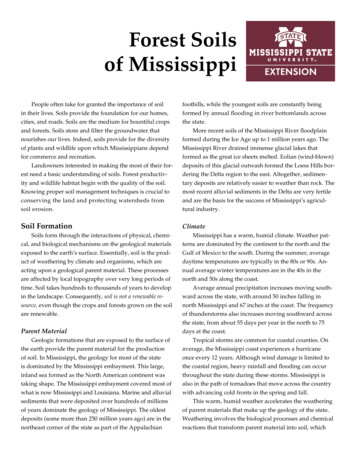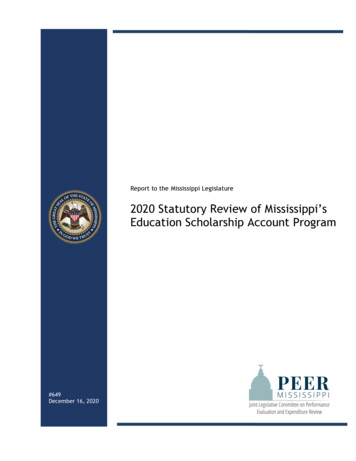
Transcription
Report to the Mississippi Legislature2020 Statutory Review of Mississippi’sEducation Scholarship Account Program#649December 16, 2020
The Mississippi LegislatureJoint Committee on Performance Evaluation and Expenditure ReviewPEER CommitteeSENATORSREPRESENTATIVESLYDIA CHASSANIOLChairKEVIN BLACKWELLDEAN KIRBYCHAD McMAHANSOLLIE NORWOODJOHN POLKCHARLES YOUNGERTIMMY LADNERVice ChairRICHARD BENNETTSecretaryCEDRIC BURNETTCAROLYN CRAWFORDBECKY CURRIEJERRY TURNERPERCY WATSONTELEPHONE:(601) 359-1226FAX:(601) 359-1420Post Office Box 1204Jackson, Mississippi 39215-1204James A. BarberOFFICE:Woolfolk Building, Suite 301-A501 North West StreetJackson, Mississippi 39201Executive Directorwww.peer.ms.govDecember 16, 2020Honorable Tate Reeves, GovernorHonorable Delbert Hosemann, Lieutenant GovernorHonorable Philip Gunn, Speaker of the HouseMembers of the Mississippi State LegislatureOn December 16, 2020, the PEER Committee authorized release of the report titled 2020Statutory Review of Mississippi’s Education Scholarship Account Program.Senator Lydia Chassaniol, ChairThis report does not recommend increased funding or additional staff.
Table of ContentsLetter of Transmittal . iReport Highlights . viiIntroduction . 1Authority, Scope, and Purpose . 1Method . 2Scope Limitation . 2Definition of Terms . 3School Choice Options in Mississippi . 3What is Mississippi’s Education Scholarship Account program, and how is it administered? . 5Description of Mississippi’s ESA Program . 5Administration of the ESA Program . 6ESA Program Budget, Disbursements, and Administrative Costs . 9Number of ESAs Awarded and Number on Waiting List . 11Nonpublic Schools Serving ESA Participants in FYs 2019 and 2020 . 13Was funding for the ESA program sufficient? . 15Extent of Use of ESA Funds. 16Increased ESA Program Funding for FY 2020 . 19How did participants utilize ESA funds for allowable expenses? . 21Use of ESA Funds . 21What is the fiscal impact on the state and on home school districts as a result of the ESAprogram? . 22How many ESA participants came from public school districts? . 24From which public school districts did the most ESA participants leave? . 25Has MDE improved its administration of the ESA program since the 2018 PEER review? . 26Improvements Made in the Administration of the ESA Program . 26Improvements Still Needed in the Administration of the ESA Program . 29Issues Regarding Reevaluations of ESA Participants. 33Have parents and students been satisfied with the ESA program? . 35Survey responses . 35Needed Program Improvements Identified by Parents and Nonpublic Schools . 36How did Senate Bill 2594 change the ESA program and what are the expected impacts? . 39Changes to Student and School Eligibility . 39Changes to Program Administration . 41Other Changes Addressing Accountability . 42Recommendations. 45PEER Report #649iii
Appendix A: Profile of ESA Recipients. 47Appendix B: Location of ESA Participants, FYs 2019 and 2020 . 49Appendix C: Nonpublic Schools Serving ESA Participants . 50Appendix D: Education Scholarship Account Satisfaction Survey Questions and Responses . 52Appendix E: Education Scholarship Account Private School Survey Questions and Responses . 56Agency Response . 58ivPEER Report #649
List of ExhibitsExhibit 1:Allowable Expenses in the ESA Program (FYs 2019 and 2020). 10Exhibit 2:ESA Program Budget, Disbursements, and Administrative Costs,FYs 2019 and 2020 . 10Exhibit 3:Disability Types for ESA Participants, FYs 2019 and 2020 . 12Exhibit 4:ESA Funds Available, Disbursements, and Amounts Returned to State Treasury,FYs 2019 and 2020 . 16Exhibit 5:Unused and Used ESAs, FYs 2019 and 2020 (Combined) . 17Exhibit 6:Number of Full and Partially Used ESAs, FYS 2019 and 2020 . 18Exhibit 7:Used and Unused Administrative Funds, FYs 2019 and 2020 . 18Exhibit 8:Percentage of ESA Expenses by Expense Type, FYs 2019 and 2020 . 21Exhibit 9:ESA Disbursements and MAEP Reductions, FYs 2019 and 2020 . 23PEER Report #649v
viPEER Report #649
PEER Report #649vii
viiiPEER Report #649
2020 Statutory Review of Mississippi’sEducation Scholarship Account ProgramIntroductionAuthority, Scope, and PurposeIn 2015 the Mississippi Legislature enacted The Equal Opportunityfor Students with Special Needs Act (Chapter 441, Laws of 2015).MISS. CODE ANN. Sections 37-181-1 et seq. (1972) direct theMississippi Department of Education (MDE) to administer theeducation scholarship account (ESA) program and outline parents’and schools’ responsibilities for program eligibility andparticipation.As stated in MISS. CODE ANN. Section 37-181-13 (1) (1972):The Joint Legislative Committee on Performance Evaluationand Expenditure Review (PEER) shall prepare a biannual1report, beginning in 2018 and every two (2) years thereafter,assessing the sufficiency of funding for educationscholarship accounts and recommending any suggestedchanges in state law or policy necessary to improve theprogram.This biennial report is the second conducted by PEER and includesa review of the program in FYs 2019 and 2020, the last two yearsof program operation.Prior to amendments made to PEER’s statutory mandate in the 2020Regular Session,2 MISS. CODE ANN. Section 37-181-13 (2) (1972)stated that PEER’s report was to assess the following:a. The level of participating students’ satisfaction with theprogram;b. The level of parental satisfaction with the program;c. Student performance on nationally standardized normreferenced achievement tests for those participating studentswhose parents have requested participation in such tests;d. Student performance on Advanced Placement examinationsor similar courses and any examinations related to college oruniversity admission;e. The high school graduation rates and college acceptancerates of participating students;1As defined in the statute, the review is to take place every two years and thus is “biennial.”2For a discussion of amendments made to MISS. CODE ANN. Sections 37-181-3 et seq. (1972) in the 2020Regular Session, refer to pages 39-44.PEER Report #6491
f. The percentage of funds used for each qualifying expenseidentified in Section 37-181-5 (2);g. The fiscal impact to the state and home school districts of theprogram, which must consider both the impact on revenueand the impact on expenses. Furthermore, the fiscal savingsassociated with students departing public schools must beexplicitly quantified, even if the public school losing thestudent(s) does not reduce its spending accordingly.Because PEER’s biennial review includes the period of July 1, 2018,through June 30, 2020, PEER assessed the ESA program accordingto its statutory mandate prior to the 2020 Regular Sessionamendments. PEER’s next biennial review in 2022 will assess theESA program with the amendments in effect.PEER conducted this review in accordance with MISS. CODE ANN.Sections 5-3-51 et seq. (1972).MethodIn conducting this review, PEER: reviewed relevant sections of the state law; interviewed managerial and ESA program staff from MDE; reviewed federal, state, and local funding information fromMDE; reviewed MDE’s ESA program data (e.g., participation data,reimbursement data); reviewed MDE’s policies and procedures for administrationof the ESA program; reviewed MDE’s website and programapplications, reimbursement forms); reviewed other states’ websites and various requirements(e.g., eligibility) for similar programs; administered a survey to 123 schools that enrolled at leastone student with an ESA in FY 2019 and/or FY 2020; and, administered a survey to 734 parents of children who wereawarded an ESA in FY 2019 and/or FY 2020.forms(e.g.,Scope LimitationFor FYs 2019 and 2020, The Equal Opportunity for Students withSpecial Needs Act did not require the collection of data by MDEregarding ESA students’ test or exam performance, graduationrates, or college acceptance rates; thus, PEER was unable to assessthose areas, as required by law.While PEER attempted to obtain some of this information in itssurvey to parents of ESA recipients (e.g., improvement on normreferenced tests), it should be noted that the parent responses PEERcollected do not reflect a complete and reliable set of data by which2PEER Report #649
to make a valid assessment for all students in the ESA program (seeAppendix D, page 52, for related survey questions and responses).Definition of TermsThe following terms are used throughout the report: ESA recipient—students who were awarded an ESA,regardless of whether they actually participated in theprogram by receiving ESA funds; ESA participant—students who were awarded an ESA andreceived ESA funds; and, Nonpublic schools—private, parochial, and independentschools.School Choice Options in MississippiMississippi offers various forms of public and nonpublic schoolchoice options to parents for their children’s education. Publicschool options include charter schools, magnet schools, and openenrollment policies in which Mississippi allows public schoolstudents to transfer to a public school of choice under certaincircumstances (e.g., when the school boards of the districtsinvolved mutually agree to allow the student to transfer, upon thewritten request of the parent or guardian).Mississippi offers the following nonpublic school choice options: Nate Rogers Scholarship for Students with DisabilitiesProgram (MISS. CODE ANN. Section 37-175-3 [1972])—Beginning in 2013, Mississippi began offering scholarshipsto students with speech-language impairments. Themaximum amount of the scholarship is equivalent to theMississippi Adequate Education Program (MAEP)3 basestudent cost. There is no maximum number of scholarshipsoffered for this program. Mississippi Dyslexia Therapy Scholarship for Students withDyslexia Program (MISS. CODE ANN. Section 37-173-3[1972])—Beginning in 2012, Mississippi began offeringscholarships to students with dyslexia. The maximumamount of the scholarship is equivalent to the MAEP basestudent cost. This scholarship is available to childrenwithout an individualized education program (IEP)4 who3The Mississippi Legislature provides funding to public schools through a formula known as the MississippiAdequate Education Program (MAEP) that calculates a “base student cost” that is derived from expendituresof school districts in instruction, administration, plant and maintenance, and ancillary (e.g., librarians andcounselors). Base student cost does not include other “add-on” funding to districts for such categories asspecial education.4An individualized education program (IEP) is a written statement for each child with a disability that isdeveloped, reviewed, and revised in a meeting as described in 34 CFR § 300.320 through § 300.324. An IEPmust take into account a child’s present levels of academic achievement and functional performance, andthe impact of the child’s disability on his or her involvement and progress in the general educationcurriculum. IEP goals must be aligned with grade-level content standards for all children with disabilities.PEER Report #6493
have a diagnosis of dyslexia. There is no maximum numberof scholarships offered for this program. Educable Child Program (MISS. CODE ANN. Sections 37-23-61through 37-23-75 [1972])—Students with disabilities are ableto receive financial assistance from the state when enrolledin the Educable Child Program. While the majority ofstudents in the program are placed by local school districts,the Department of Human Services, or Child ProtectiveServices, the program does allow for parents to place theirchild in an MDE-approved nonpublic school after submittingthe required documentation. Parents can receivereimbursement of up to 3,000 per year.In addition, Mississippi allows parents to homeschool and enrolltheir children in nonpublic schools.Mississippi’s addition of an Education Scholarship Accountprogram in 2015 expanded parents’ options for nonpublic schoolchoice by allowing all categories of students with disabilities toqualify and by providing funds for nontuition educational expenses(e.g., tutoring, textbooks). The Nate Rogers Scholarship anddyslexia scholarship cover tuition only and require students toattend a limited number of state-approved schools, while ESAsallow parents to choose from many schools across the state thatmeet certain requirements (e.g., accreditation). To qualify for theNate Rogers Scholarship, a student must have been enrolled inpublic school the previous year; thus, students already enrolled ina nonpublic school are not eligible. However, these students areeligible for an ESA.According to the National Conference of State Legislatures,proponents of ESAs argue that giving parents a variety of optionswith which to spend the funds will make them more mindful of thequality and cost of services, allowing them to maximize the valueof the scholarship. Having multiple options allows parents tocustomize their child’s educational experience to best meet theirindividual needs. Furthermore, they argue that ESAs increasecompetition among schools, which forces schools to raise theiracademic quality and decrease costs to increase enrollment.Opponents of ESAs express concern that the programs lackaccountability to ensure that students are receiving a high-qualityeducation and that funds are being used appropriately. Also,opponents contend that public funds are being shifted away fromstruggling public schools and instead given to nonpublic schoolsthat are held less accountable.4PEER Report #649
What is Mississippi’s Education Scholarship Accountprogram, and how is it administered?This chapter discusses the following: description of Mississippi’s ESA program; administration of the ESA program; ESA program budget, disbursements, and administrativecosts; number of ESAs awarded, and number of applicants onwaiting list; and, nonpublic schools serving ESA students in FYs 2019 and FY2020.Description of Mississippi’s ESA ProgramIn its 2015 Regular Session, the Legislature passed The Equal Opportunity for Students withSpecial Needs Act, which directs the Mississippi Department of Education (MDE) toimplement an Education Scholarship Account (ESA) program in the state on a phased-inbasis. The program’s purpose is to offer parents of children with disabilities financialassistance to place their children in a nonpublic school setting and receive other educationalservices that parents believe best meet the needs of their child.MISS. CODE ANN. Sections 37-181-1 et seq. (1972), The EqualOpportunity for Students with Special Needs Act, passed by theLegislature during the 2015 Regular Session, directs theDepartment of Education to implement a five-year EducationScholarship Account pilot program. According to MISS. CODE ANN.Section 37-181-7 (1972), the program was limited to 500 studentsin the first school year (2015–2016) with new enrollment limited to500 additional students each subsequent year. However, theprogram has not grown as authorized in law because the program’sbudget has not increased steadily each year through legislativeappropriations. If MDE had awarded ESAs to up to 500 students peryear (and if enough students applied), the total number of awardswould have grown to 2,500 for FY 2020.The program’s budget of 5 million for FY 2020 provided for amaximum of 712 ESAs. Of the 712 ESAs, MDE awarded ESAs to alleligible students who had applied from 2015 through 2019 andwere placed on a waitlist. Therefore, the number of studentsapplying for the program has not necessitated the 2,500 spotsanticipated in state law. (See page 12 for actual number ofparticipating students.)The Act set an initial amount of 6,500 for each ESA in school year2015–2016, with annual adjustments proportionate to the annualadjustments made to the Mississippi Adequate Education Program(MAEP) base student cost. For the 2019-2020 school year, the ESAamount was 6,765.The ESA program offers parents of children with disabilitiesfinancial assistance to place their children in a nonpublic schoolPEER Report #6495
setting and receive other educational services that parents believebest meet their child’s needs.To be awarded an ESA in FYs 2019 and 2020, a student must havehad an individualized education program (IEP) within the past fiveyears.5 According to the U.S. Department of Education, each publicschool student who receives special education and related servicesm
Dec 16, 2020 · The percentage of funds used for each qualifying expense identified in Section 37-181-5 (2); g. The fiscal impact to the state and home school districts of the . The following terms are used throughout the report: ESA recipient—students who were awarded an ESA,
